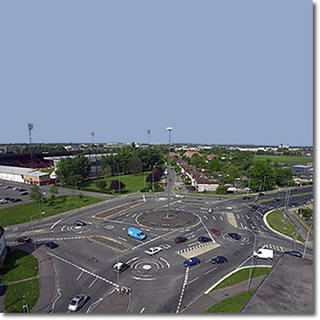As you may know, traffic in England circulates on the left side of the road. This has many consequences for the design of cars and for traffic flow. Most of these consequences are simply mirror-images of what North American drivers are used to, but they can range from simple adjustments to things that are frighteningly dangerous.
For example, the steering wheels in most British cars are on the right side. Things like the brake and accelerator pedals are not reversed, but the rear view mirrors and the gear shift and parking brake are. This means that while I can easily accelerate and brake in a rented car, I often bang my hand on the right-side door when it's time to use the stick shift, and I will look up and out the window when trying to see who is behind me, rather than looking at the rear-view mirror. That much can be adapted to fairly easily, but judging where I am driving in my lane is a different matter - and very difficult when on a narrow street, or parallel parking. Shearing off rear view mirrors is a common problem for tourists.
However, getting used to the traffic flow is what is truly unnerving. Driving straight ahead is fine (except on narrow lanes, as noted above), but once you have to make a turn, well, get ready, because your brain just screams WRONG! at you, and you have to consciously turn into what you fear is the oncoming lane. It is left turns that are easy, and right turns that cross traffic.
The real nightmare is the traffic circle, or 'roundabout,' as is called in Britain. Traffic circulates to the left, or clockwise, and Britain is full of these roundabout things. A very famous roundabout happens to be in Swindon, where my friend is working. Imagine coming across the following road sign, and trying to sort out what it all means, as you sail by at 45 mph:

Take a close look at that sign - there are five mini-roundabouts within a mega-roundabout. And suddenly, you are faced with the real thing:

Note that the very inner part circulates in the opposite direction from the exterior. My friend avoids this area of town as much as possible in order to avoid encoutering this thing - but she was caught in it last weekend, and had to navigate the "Magic Roundabout," getting out of it at the first opportunity, and then regrouping (hopefully without being forced onto it again).
In the past she has had several bad experiences as a passenger in England - things like rearview mirrors flying through the window, sheared off doors and such, so I can cut her some slack on being nervous. Luckily, there are alternative tactics while in traffic structures like these, but I suspect these are not handed out in the literature car rental agencies supply:

So: are you a pro, or a tourist?
Here's a really great page showing GPS paths through the Magic Roundabout.
2 comments:
Pro. Always drive the Pro route, several times a week. Even though I'm not British by birth. It's a piece of cake.
But I wouldn't drive 45mph anywhere near the thing. The speed limit is 30mph and speeding can be very expensive...
Driving on the left isn't so bad, as I had ample opportunity to do it in Australia. I do admit, I was a bit unnerved the first time I was asked to move my girlfriend's car out of the driveway to find myself sitting on the right with the manual shift on the left. Tooling around NZ, though, I got used to it. It took others to notice that I had a tendency to drive to far to the left hand side of the lane, probably since I now had all the traffic on my side and was doing my best to avoid a head on. For what it's worth, Australia's worst round about was near where I lived in Canberra. Huge numbers of accidents there every year. Just proves that the Brits/Aussies aren't pros at them either.
Post a Comment